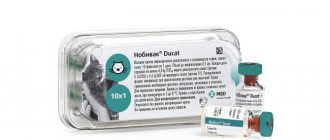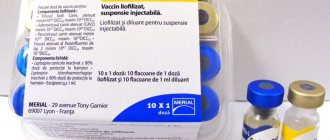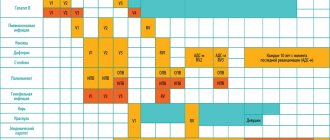general description
Gardasil is a vaccine, given as an injection (shot), to protect girls and young women, boys and young men from disease caused by the human papillomavirus.
Gardasil for girls and women aged 9 to 26 years protects against female diseases caused by this virus:
- Cervical cancer;
- Genital warts;
- Cancer of the vulva and vagina;
- Anal cancer;
- Precancerous lesions of the genital area.
At the same age, the vaccine is also given to boys and young men. It protects against dangerous diseases caused by the human papillomavirus.
- Genital warts;
- Anal cancer;
- Precancerous lesions of the anus.
Gardasil only provides protection against disease caused by a specific type of this virus, it targets virus types 6, 11, 16, 18. Most cases of the diseases listed above are caused by these 4 types of HPV. The vaccine does not protect against all other viruses and bacteria, and other types of HPV. It is not intended to treat HPV infection. Use is indicated for protection and prevention against infection.
Table of contents:
- What is human papillomavirus?
- How are HPVs transmitted and how common are they?
- How is HPV infection diagnosed?
- How is HPV infection treated?
- What is the connection between HPV infection and cervical cancer?
- How to reduce the risk of HPV infection?
- What is the Gardasil vaccine?
- Who is recommended for Gardasil vaccination?
- Should boys be vaccinated?
- What are the contraindications to HPV vaccination?
- Is it possible to get vaccinated during pregnancy and breastfeeding?
- How common are reactions to Gardasil vaccination?
- How does Gardasil interact with other vaccines?
- Vaccination procedure
- How effective is the Gardasil vaccine?
- Do I need to do a PCR or Pap test before vaccination?
- How safe is the HPV vaccination?
Description
Gardasil is an injection usually given into a muscle in the arm. The vaccinated person will need to go through 3 stages indicated in the vaccine administration schedule:
- Dose 1 is taken on the day of the first vaccination;
- Dose 2 is administered 2 months after the first injection;
- Dose 3 is required 6 months after the first dose.
Make sure all 3 doses are received on time to get the best protection. If you miss one dose, do not ignore this issue, talk to your doctor.
Contraindications
You should not take Gardasil if you have or experience:
- Allergic reactions after the last use of Gardasil;
- Severe allergic reaction to yeast, amorphous aluminum hydroxyphosphate sulfate, polysorbate 80.
Before taking Gardasil, you must tell your doctor:
- If you are pregnant or intend to become pregnant, the vaccine is not recommended for this category of women;
- About problems with immunity, the presence of HIV infection, cancer, or taking medications that affect the body’s immune system;
- Temperature elevated to more than 37.8°C;
- About the occurrence of an allergic reaction after the next dose of Gardasil;
- About taking any medications sold without a prescription.
Your doctor will help you decide whether you can get vaccinated now.
Also tell your doctor if you have any of the following problems after the vaccine:
- With swollen glands in the neck, armpits, groin;
- Chills and general malaise;
- Joint pain;
- tiredness, unusual weakness, confusion;
- Pain in legs, muscles, chest, abdomen;
- Shortness of breath, bleeding, skin infection and other symptoms.
Gardasil
| Vaccine against human papillomavirus, quadrivalent recombinant (types 6, 11, 16, 18) Manufacturer: MERCK & Co., Inc., USA |
Registration number LS-002293 dated November 24, 2006.
Dosage form Suspension for intramuscular administration. Quadrivalent human papillomavirus (HPV) vaccine is a sterile intramuscular suspension prepared from a mixture of highly purified virus-like particles (VLPs) of the recombinant major capsid protein (L1) of HPV types 6, 11, 16, and 18. L1 proteins are produced by separate fermentation in recombinant Saccharomyces cerevisiae CANADE 3C-5 (strain 1895) and form VHF by self-assembly. VLPs for each type are purified and adsorbed on an aluminum-containing adjuvant (amorphous aluminum hydroxyphosphate-sulfate).
Composition One dose (0.5 ml) contains:
Active substances-immunogens Recombinant antigens: L1 protein of human papillomavirus in the following ratios: type 6 (20 μg), type 11 (40 μg), type 16 (40 μg), type 18 (20 μg). Excipients: Aluminum in the form of an adjuvant - amorphous aluminum hydroxyphosphate sulfate - 225 mcg, sodium chloride - 9.56 mg, L-histidine - 0.78 mg, polysorbate - 80 - 50 mcg, sodium borate - 35 mcg, water for injection .
Description Opaque white suspension.
Immunobiological properties Carrying out a full course of vaccination leads to the formation of specific antibodies to four types of HPV - 6, 11, 16 and 18 - in a protective titer in more than 99% of vaccinated people for a period of at least 36 months in all age groups. The Gardasil vaccine is almost 100% effective in preventing genital cancers, precancerous epithelial dysplasias and genital warts induced by HPV types 6, 11, 16 and 18.
Purpose The Gardasil vaccine is indicated for use in children and adolescents aged 9 to 17 years and young women aged 18 to 26 years to prevent the following diseases caused by human papillomavirus types 6, 11, 16 and 18:
- cancer of the cervix, vulva and vagina
- genital warts (condiloma acuminata)
Precancerous dysplastic conditions:
- cervical adenocarcinoma in situ (AIS)
- cervical intraepithelial neoplasia grades II and III (CIN 2/3)
- vulvar intraepithelial neoplasia grades II and III (VIN 2/3)
- vaginal intraepithelial neoplasia grades II and III (VaIN 2/3)
- cervical intraepithelial neoplasia grade I (CIN 1)
Method of administration and dosage The Gardasil vaccine is administered intramuscularly into the deltoid muscle or anterolateral thigh area. Do not administer intravenously. A single dose of the vaccine for all age groups is 0.5 ml. The recommended course of vaccination consists of 3 doses and is carried out according to the scheme (0 - 2 - 6 months): First dose - on the appointed day. The second dose is 2 months after the first. The third dose is 6 months after the first. An accelerated vaccination schedule is allowed, in which the second dose is administered after 1 month. after the first vaccination, and the third - after 3 months. after the second vaccination. If the interval between vaccinations is violated, the vaccination course is considered completed if three vaccinations are carried out within 1 year. The vaccine is ready for use; no additional dilution or resuspension is required. Before use, the vial/syringe with the vaccine is shaken until a homogeneous cloudy suspension is obtained. Loss of homogeneity, the appearance of included particles and changes in the color of the suspension indicate the unsuitability of the vaccine. The syringe filled with the vaccine is for one time use only and for one person only. The opening of the bottles and the vaccination procedure are carried out in strict compliance with the rules of asepsis and antiseptics. The injection site is treated with 70% alcohol before and after the injection. The entire recommended dose should be administered.
Using single-dose vaccine vials: Draw 0.5 ml of the suspension from the single-dose vaccine vial with a sterile needle into a disposable syringe that does not contain preservatives, antiseptics or detergents. Give the full dose. Throw away the bottle with any remaining vaccine.
Using single dose syringes Inject the entire contents of the syringe.
Instructions for use of disposable, sterile, pre-filled single dose syringes complete with safety device. Use the included needle to administer the vaccine. If you want to use another one, make sure that the needle is securely attached to the syringe and its length does not exceed 2.5 cm, which is a necessary condition for the correct operation of the safety device. Remove the cap from the end of the syringe. Press both anti-rotation tabs to secure the syringe and attach the Luer needle by turning clockwise. Remove the protective cap from the needle. When injecting as above, press the plunger while holding the syringe firmly under your finger tips and inject the entire dose. The needle guard will not work unless the entire dose is injected. Remove the needle. Release the plunger and allow the syringe to move upward until the entire needle is completely covered. To document vaccinations, peel off the removable labels by slowly pulling them out. Dispose of the syringe in a sharps container.
Side effects After administration of the vaccine, local and general reactions may develop in some cases: according to clinical studies, the following adverse events occurred with a frequency of at least 1.0% and more often than in the placebo group. Local reactions are expressed in redness, swelling, pain and itching at the injection site. The duration of reactions does not exceed 5 days and does not require drug therapy. The most typical general reactions are headache and short-term increase in body temperature. Isolated cases of gastroenteritis and inflammation of the pelvic organs have been reported. Considering the theoretical possibility of developing immediate allergic reactions in particularly sensitive individuals, it is necessary to provide medical supervision of vaccinated individuals for 30 minutes. Vaccination sites must be provided with anti-shock therapy.
Contraindications Hypersensitivity to the active components and fillers of the vaccine. If hypersensitivity symptoms occur after administration of the Gardasil vaccine, administration of a subsequent dose of the vaccine is contraindicated. Bleeding disorders due to hemophilia, thrombocytopenia, or while taking anticoagulants are a relative contraindication to intramuscular administration of the Gardasil vaccine, unless the potential benefits of vaccination significantly outweigh the risks associated with it. If the choice is made in favor of vaccination, it is necessary to take measures to reduce the risk of post-injection hematoma formation.
Pediatric Use: The safety and effectiveness of Gardasil vaccine have not been evaluated in children under 9 years of age.
Pregnancy and lactation The Gardasil vaccine is classified as category “B”. There are no specifically designed and well-controlled studies in pregnant women. The potential impact of the vaccine on female reproductive function and on the fetus in pregnant women has not been studied. There is no evidence that Gardasil vaccine has adverse effects on fertility, pregnancy, or the fetus. Gardasil vaccine can be given to breastfeeding women.
Interaction with other drugs
Use with other vaccines Clinical trial results indicate that Gardasil vaccine can be administered at the same time (at a different site) with recombinant hepatitis B vaccine.
Use with common medications The use of analgesics, anti-inflammatory drugs, antibiotics and vitamin preparations did not affect the effectiveness, immunogenicity and safety of the vaccine.
Use with hormonal contraceptives The use of hormonal contraceptives did not affect the immune response to the Gardasil vaccine.
Use with steroids Inhaled, topical and parenteral steroids did not affect the immune response of the Gardasil vaccine.
Use with systemic immunosuppressants There are no data on the simultaneous use of strong immunosuppressants and the Gardasil vaccine.
Warnings Subcutaneous or intradermal administration of the vaccine has not been studied and is therefore not recommended. Gardasil is not intended to treat: cancer of the cervix, vulva, or vagina, CIN, VIN, or VaIN, or active condylomatosis. The drug does not protect against diseases caused by other types of HPV and other etiologies. As with any injectable vaccine, you should always have appropriate medications on hand in case of a rare anaphylactic reaction to the vaccine. The decision to administer or delay vaccination due to current or recent illness accompanied by fever depends largely on the etiology of the illness and its severity. Mild fever and mild upper respiratory tract infection are usually not contraindications for vaccination. In persons with impaired immune system reactivity due to the use of immunopressive therapy (systemic corticosteroids, antimetabolites, alkylating drugs, cytotoxic drugs), a genetic defect, infection with the human immunodeficiency virus (HIV) and other reasons, the protective effect may be reduced. Gardasil vaccine should be administered with caution to persons with thrombocytopenia and any bleeding disorders as bleeding may occur in such persons after intramuscular injection. Health care personnel must provide all necessary information about vaccination and the vaccine to patients, parents and caregivers, including information about the benefits and risks associated with them. Vaccines should be warned about the need to protect against pregnancy during the course of vaccination, about the need to report any adverse reactions to the doctor or nurse, and that vaccination does not replace or cancel routine screening examinations. To achieve effective results, the vaccination course must be completed in full, unless there are contraindications.
Use in geriatrics There are no data assessing the safety and effectiveness of the Gardasil vaccine in adults over 26 years of age.
Overdose There have been reports of cases of administration of the Gardasil vaccine in doses exceeding those recommended. In general, the nature and severity of adverse events during overdose were comparable to those with the introduction of recommended single doses of the Gardasil vaccine.
Release form
Bottle Primary packaging: 1 dose (0.5 ml) is placed in a bottle (volume - 3 ml) made of tubular borosilicate glass. The bottle is sealed with a Teflon-coated chlorobutyl stopper under an aluminum trim and closed with a green snap-on plastic cap. Secondary packaging: 1 or 10 bottles are placed in a cardboard box along with instructions for use.
Disposable syringe Primary packaging: 1 dose (0.5 ml) in a disposable sterile syringe (volume - 1.5 ml) made of borosilicate glass. The syringe with (or without) a safety insertion device is equipped with a polycarbonate adapter, a protective bromobutyl cap and a piston closed with a butyl rubber stopper, coated with silicone. 1 disposable, sterile, pre-filled syringe complete with 1 or 2 sterile needles (or no needles) placed in a blister pack with a lid. 6 disposable, sterile, pre-filled syringes, complete with 1 or 2 sterile needles (or no needles) per cell, placed in a blister pack with lid. Secondary packaging: 1 or 6 disposable sterile syringes, sealed in a blister pack with a lid, placed in a cardboard box along with instructions for use.
Storage conditions At temperatures from 2° to 8°C, in a place protected from light. Do not freeze. Keep out of the reach of children. Shelf life : 3 years. Do not use after the expiration date indicated on the package or if there is a visual change in the physical properties of the suspension.
Conditions for dispensing from pharmacies By prescription.
A set of 6 disposable sterile syringes or 10 bottles is intended for sanitary and preventive treatment institutions.
Side effects
After taking Gardasil, a person may faint. In this case, he may get injured and get hurt. Therefore, it is necessary to remain under the medical supervision of your doctor for at least 15 minutes after receiving the vaccine. Some people may tremble and become stiff when they lose consciousness. This may require treatment and a course of therapy from your doctor.
Side effects of Gardasil include:
- Headache and dizziness, fainting;
- Swelling, redness, bruising, pain and itching at the injection site;
- Nausea, vomiting, fever.
Tell your doctor if you experience signs of an allergic reaction. It can be:
- Difficulty breathing;
- Bronchospasm, wheezing;
- Rash, hives.






